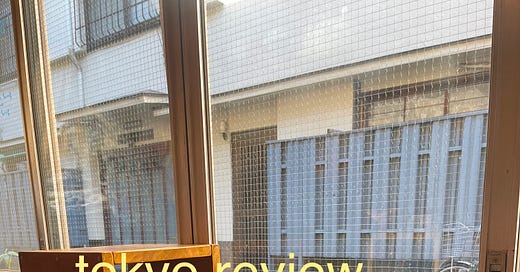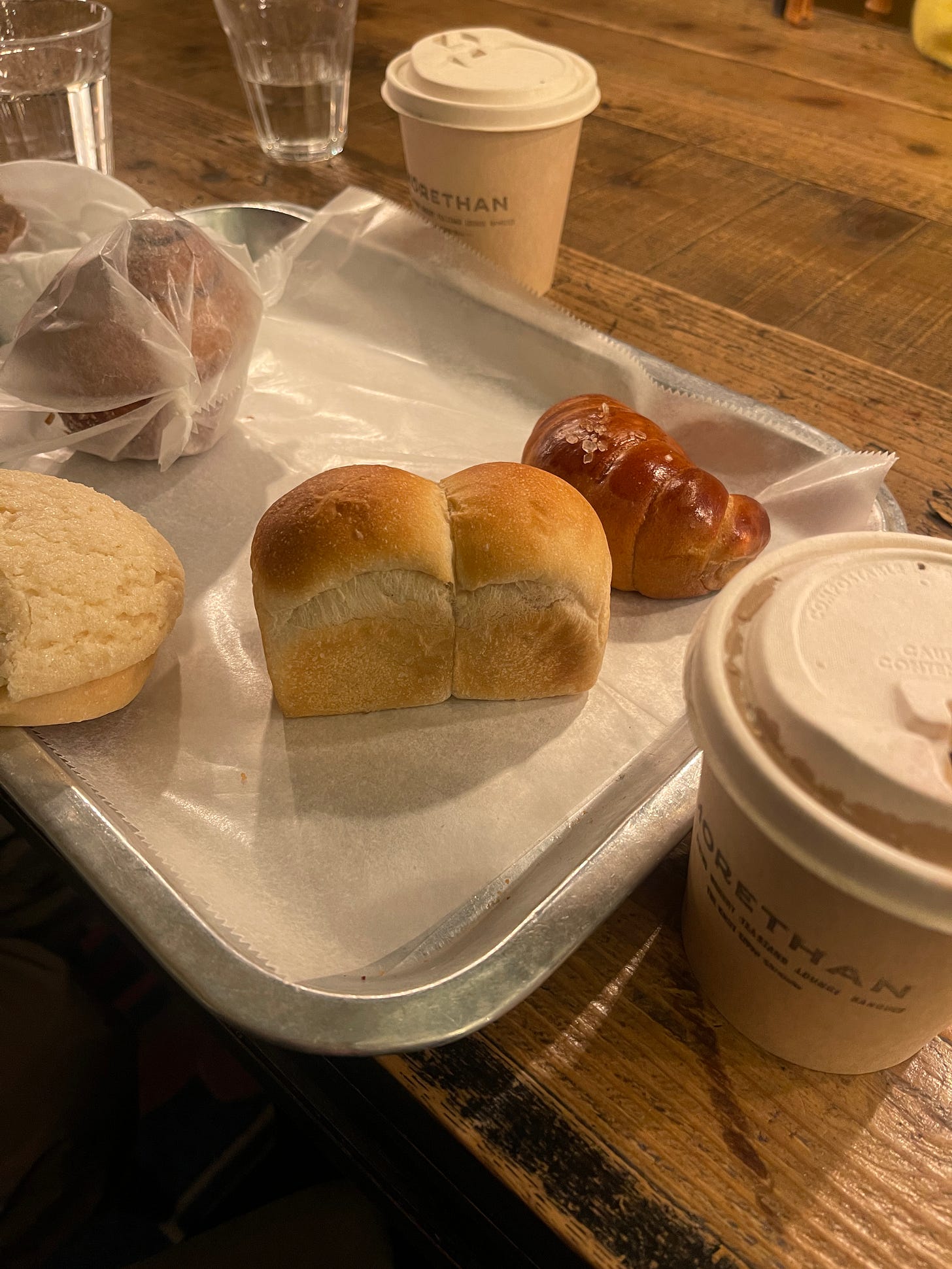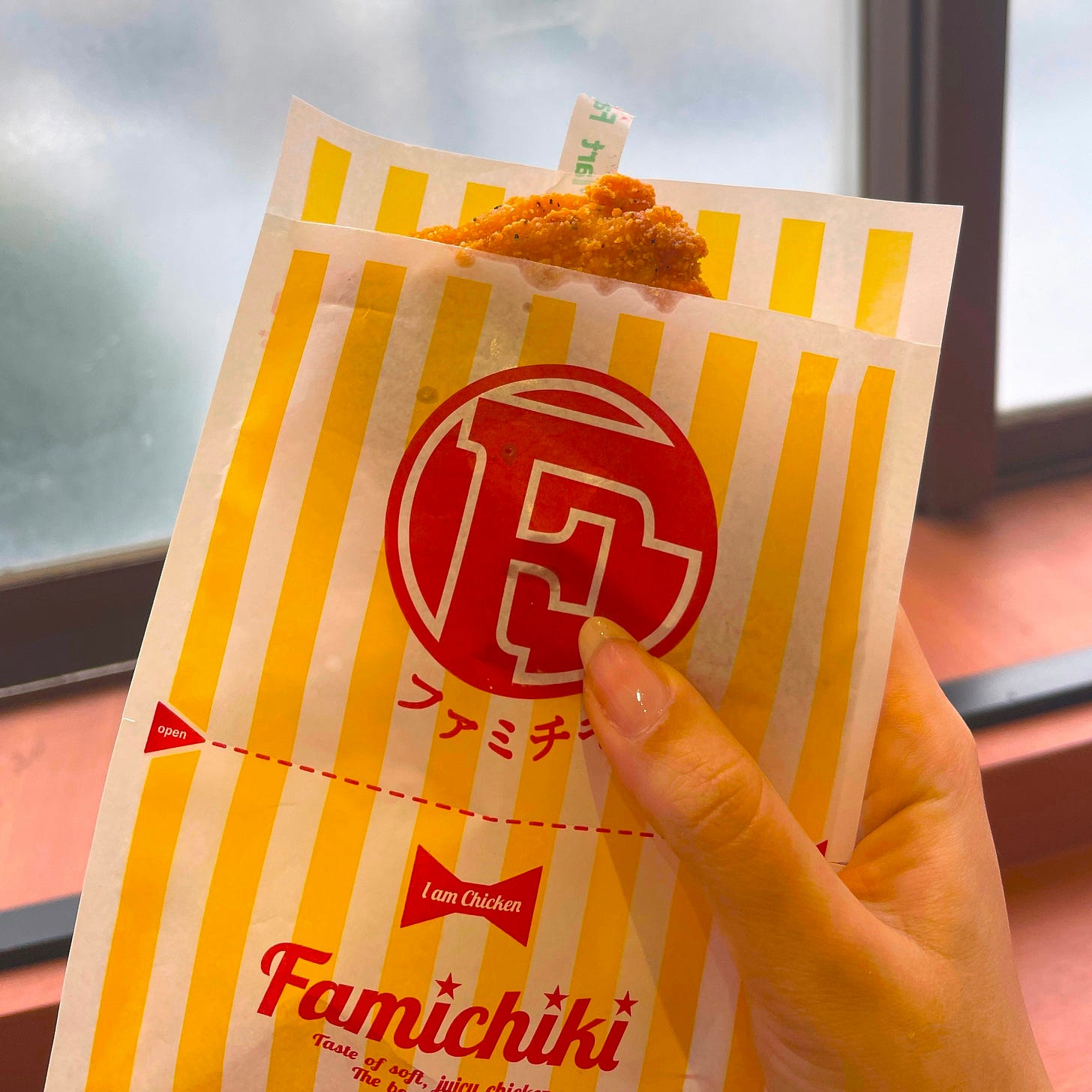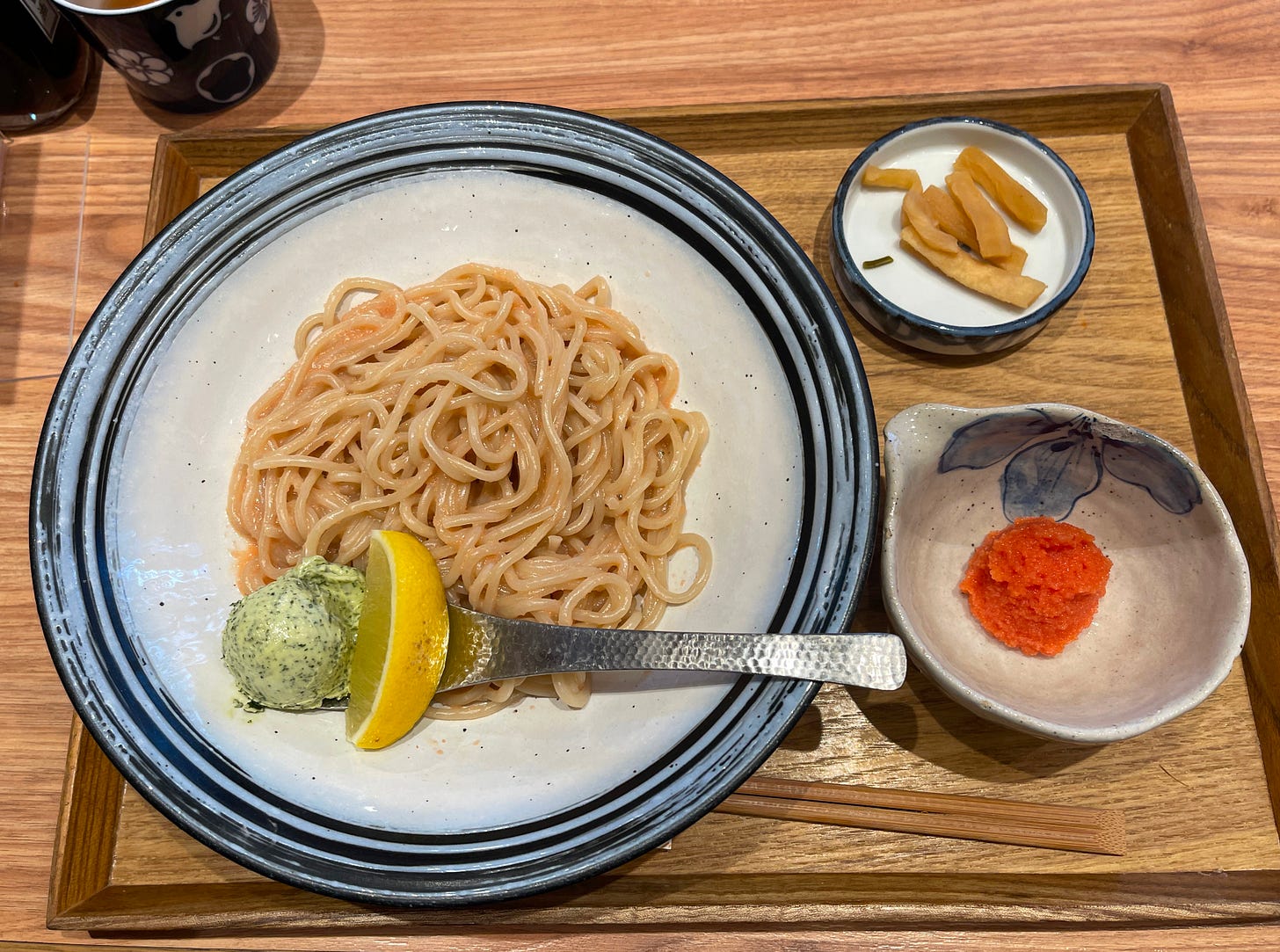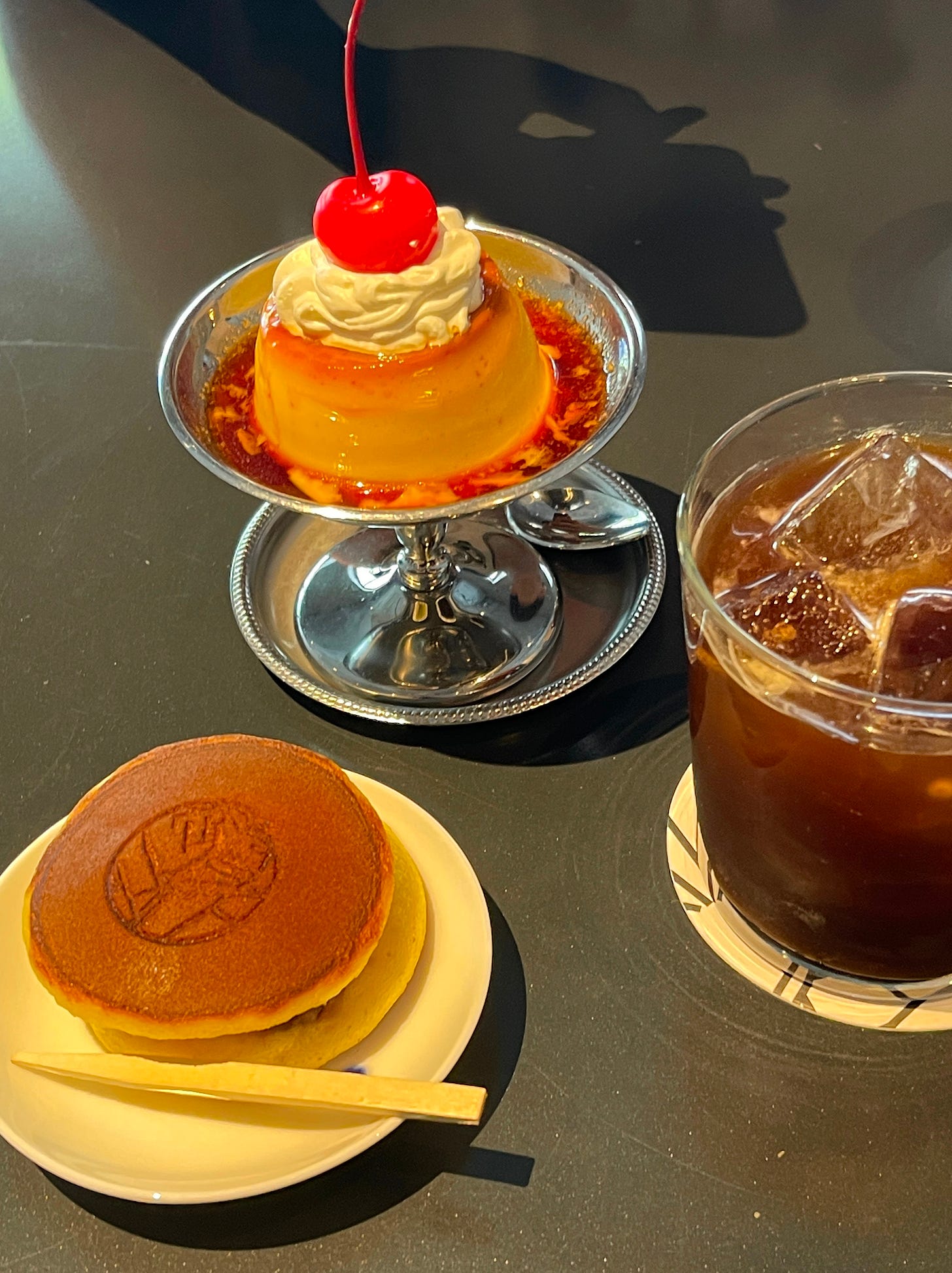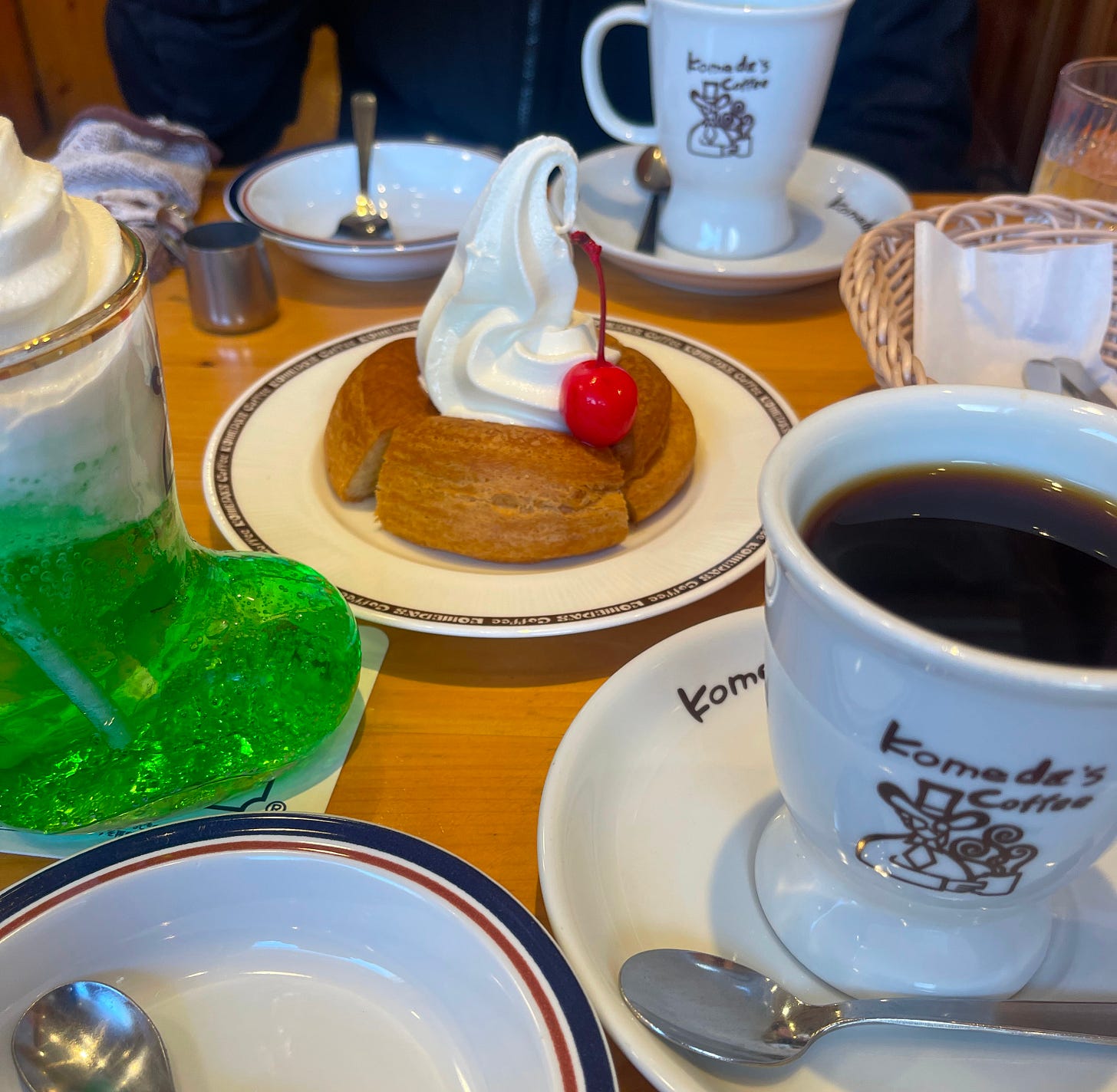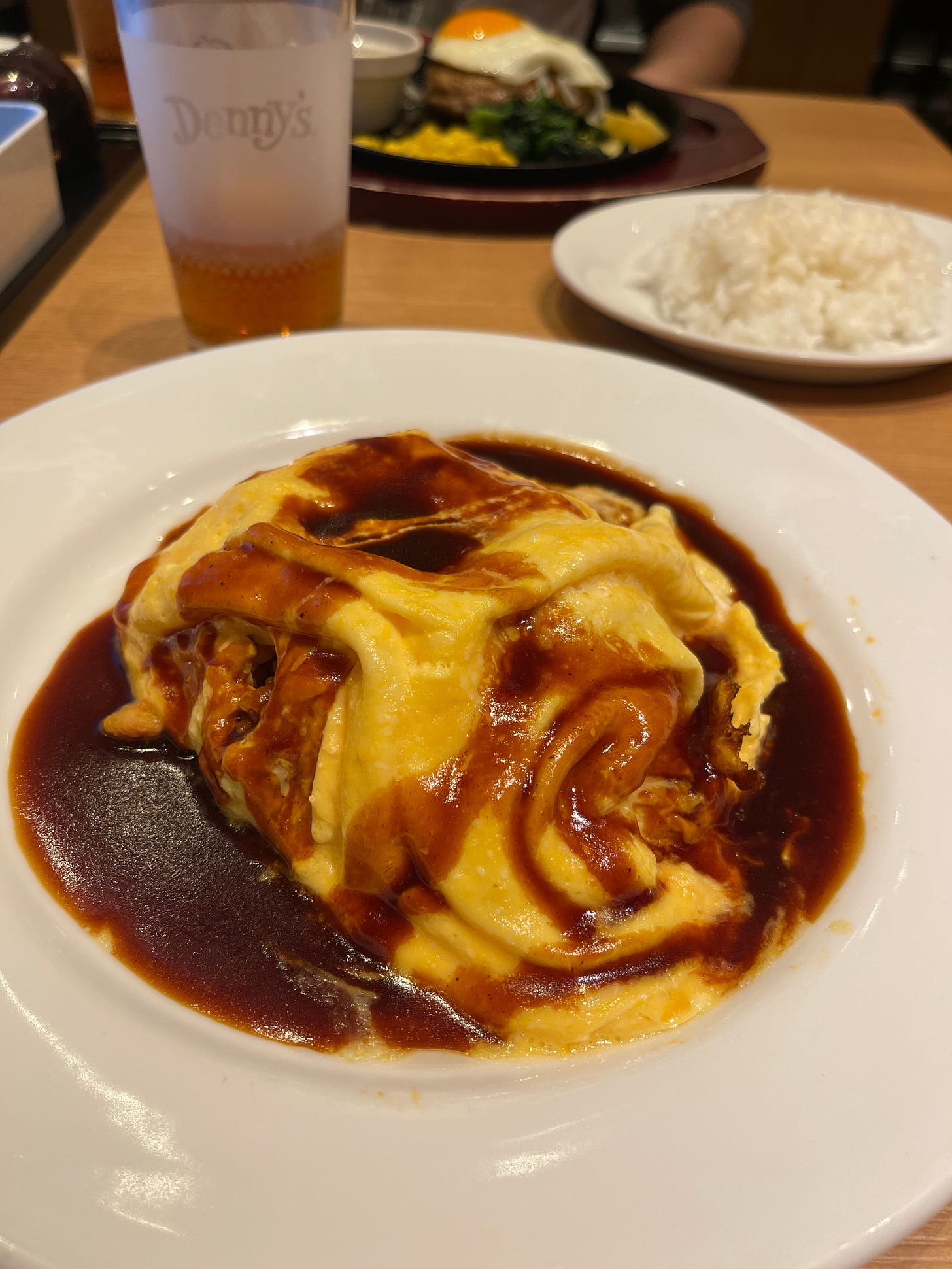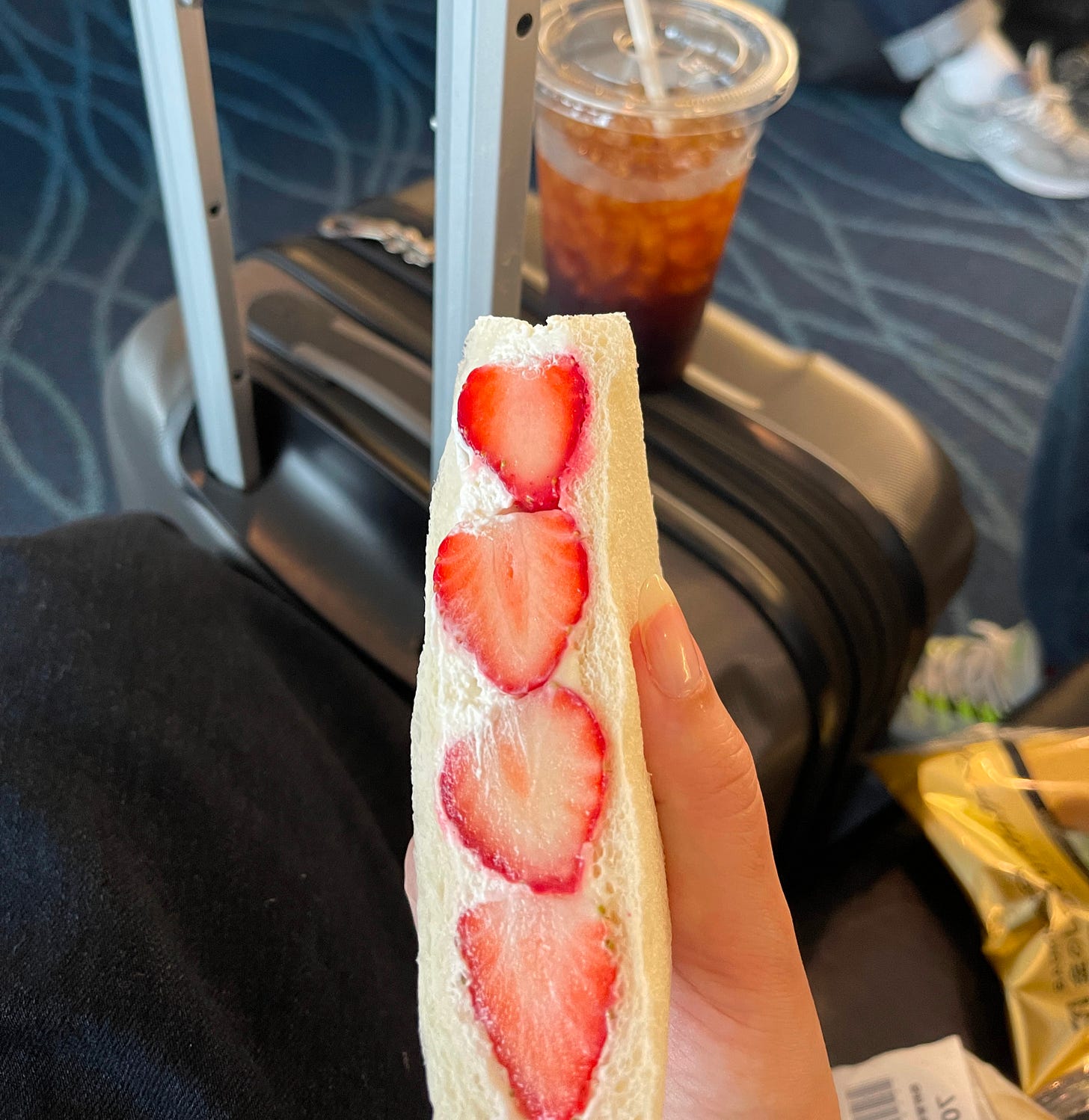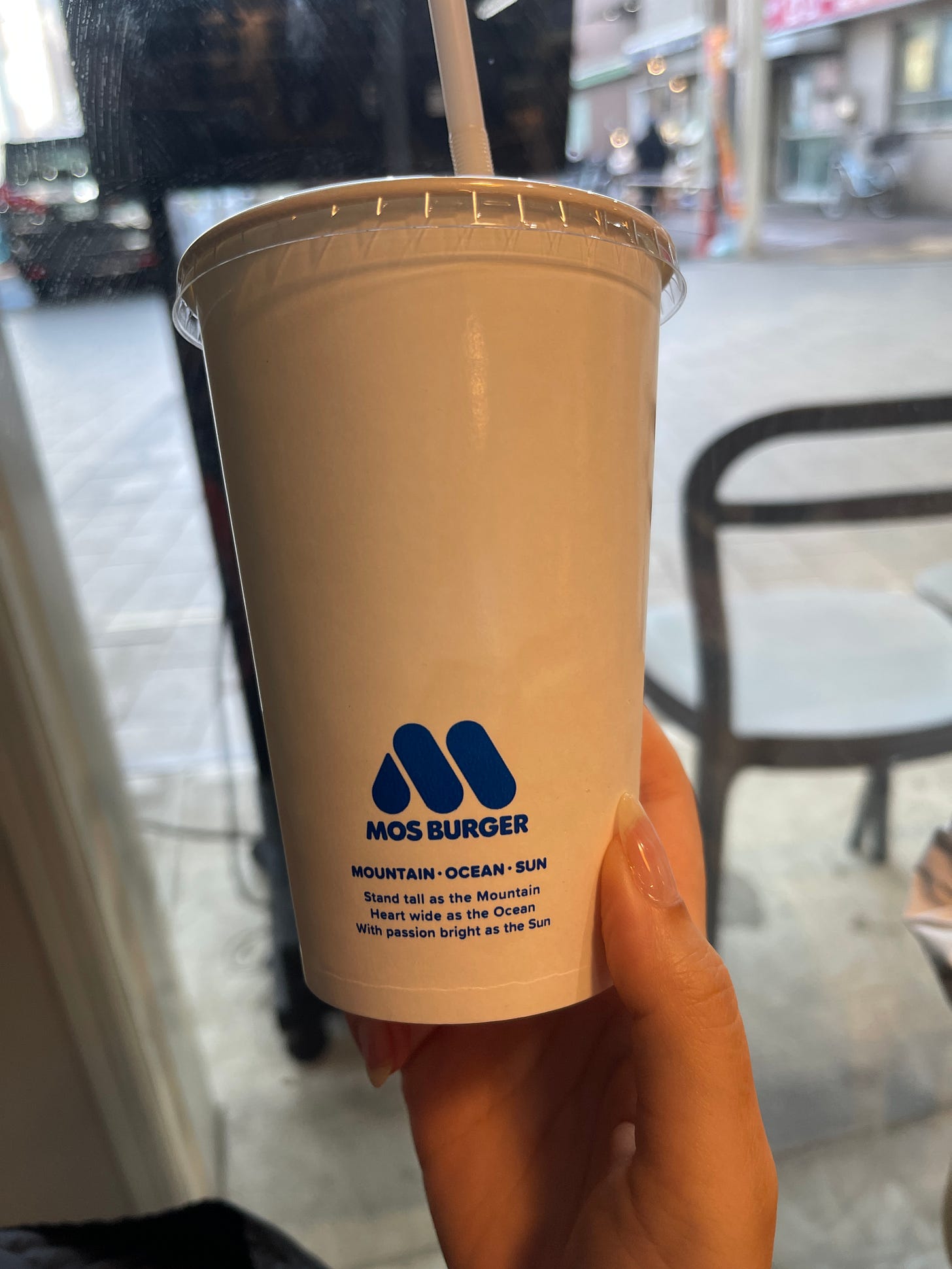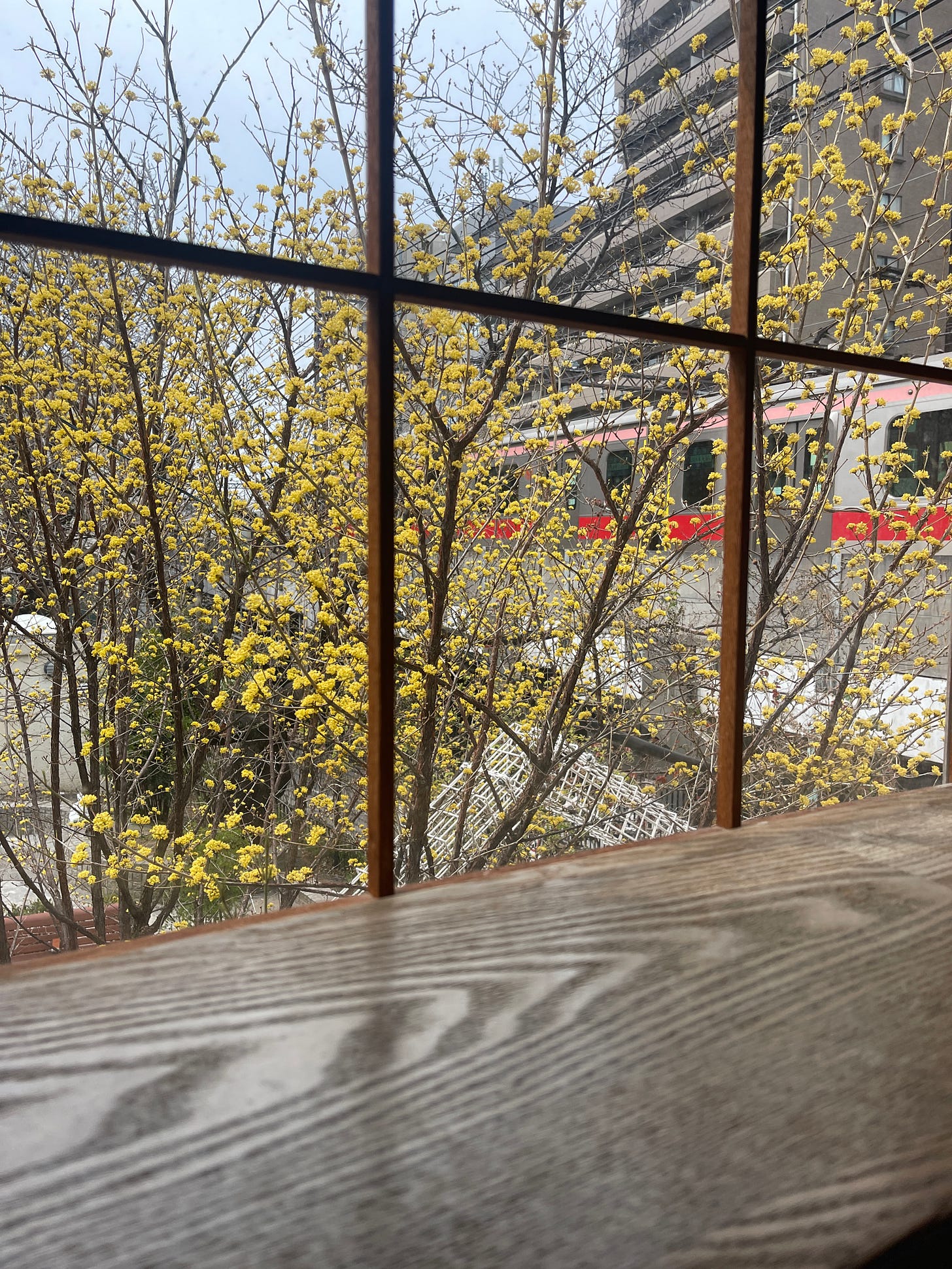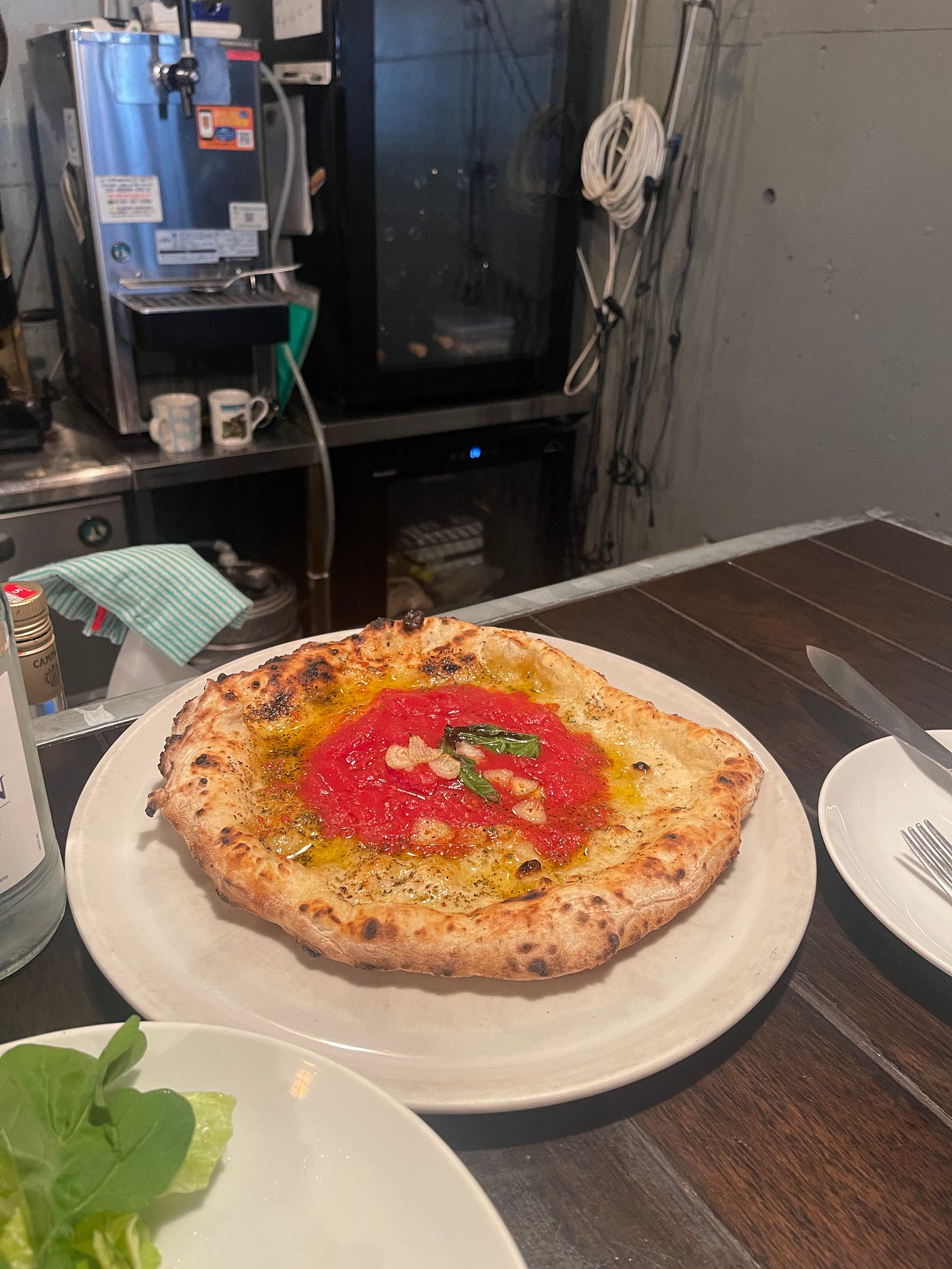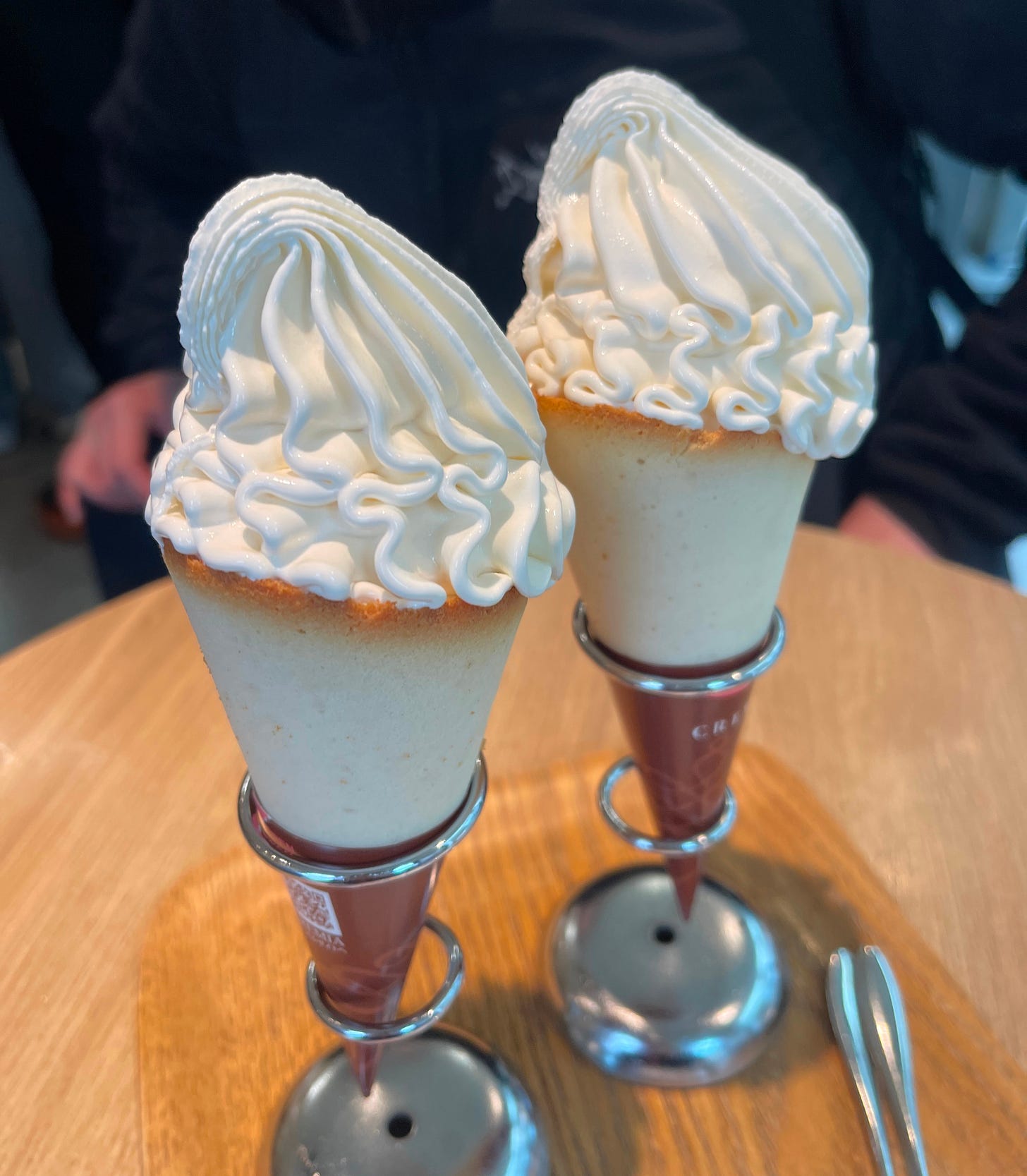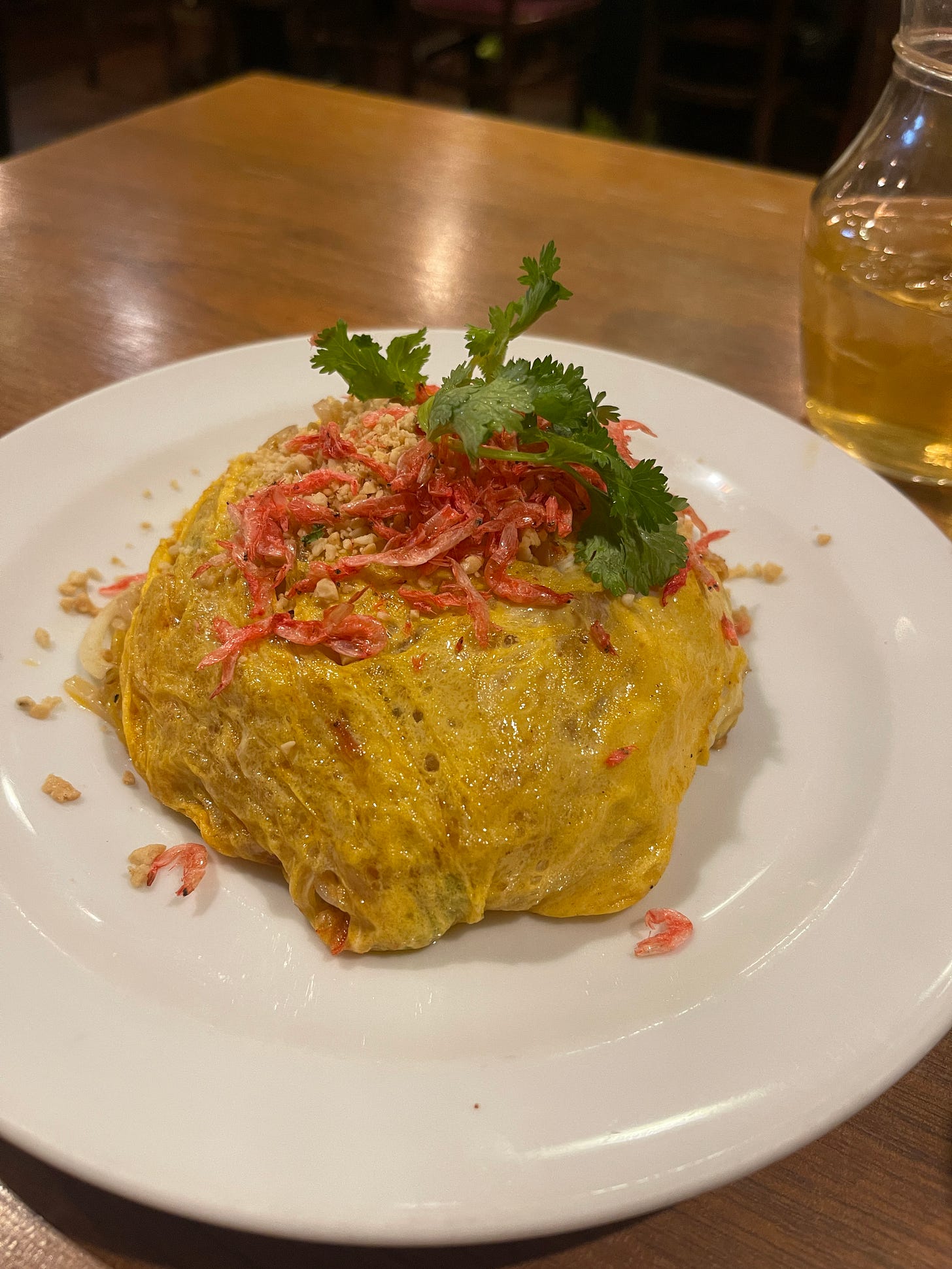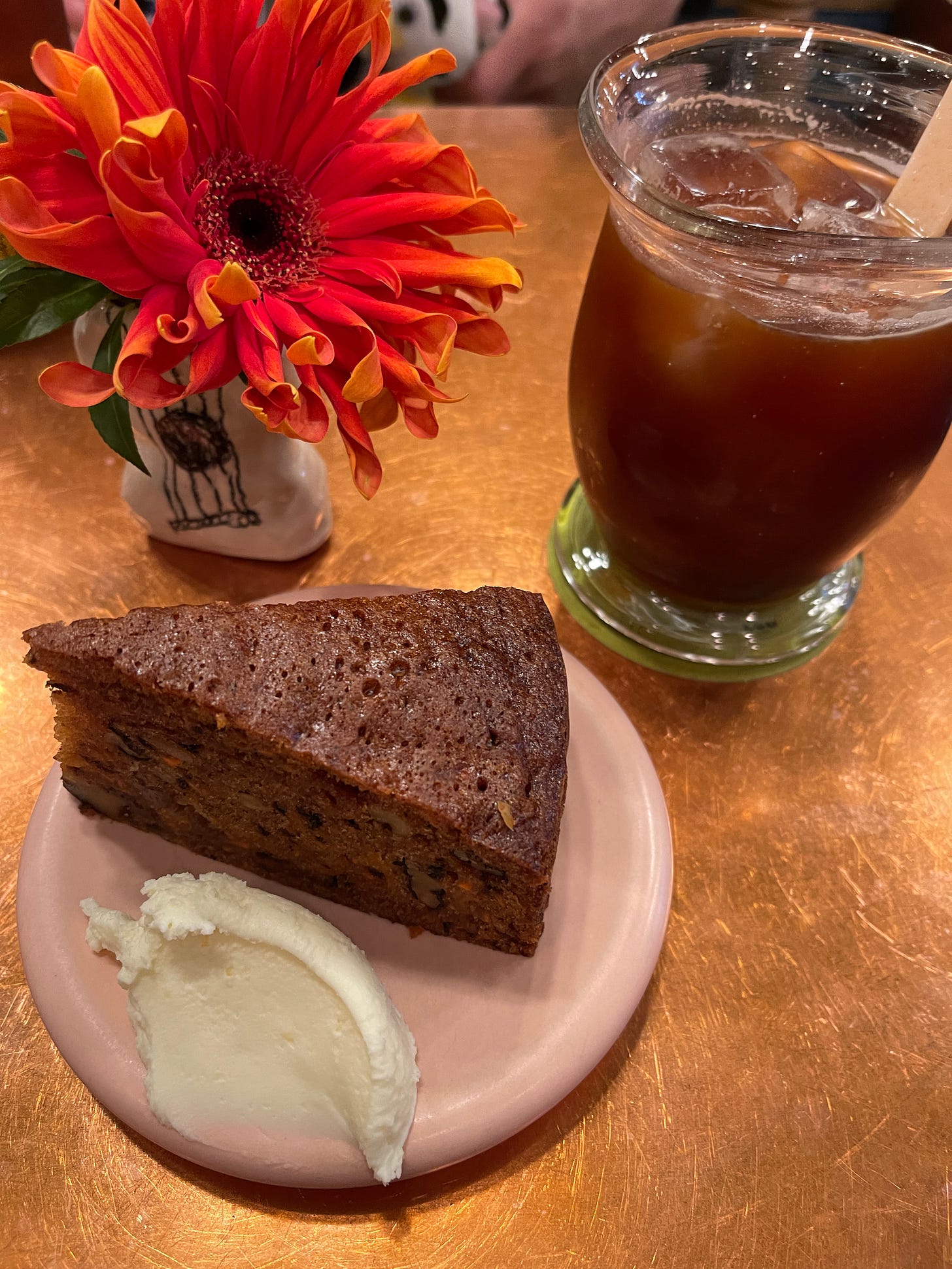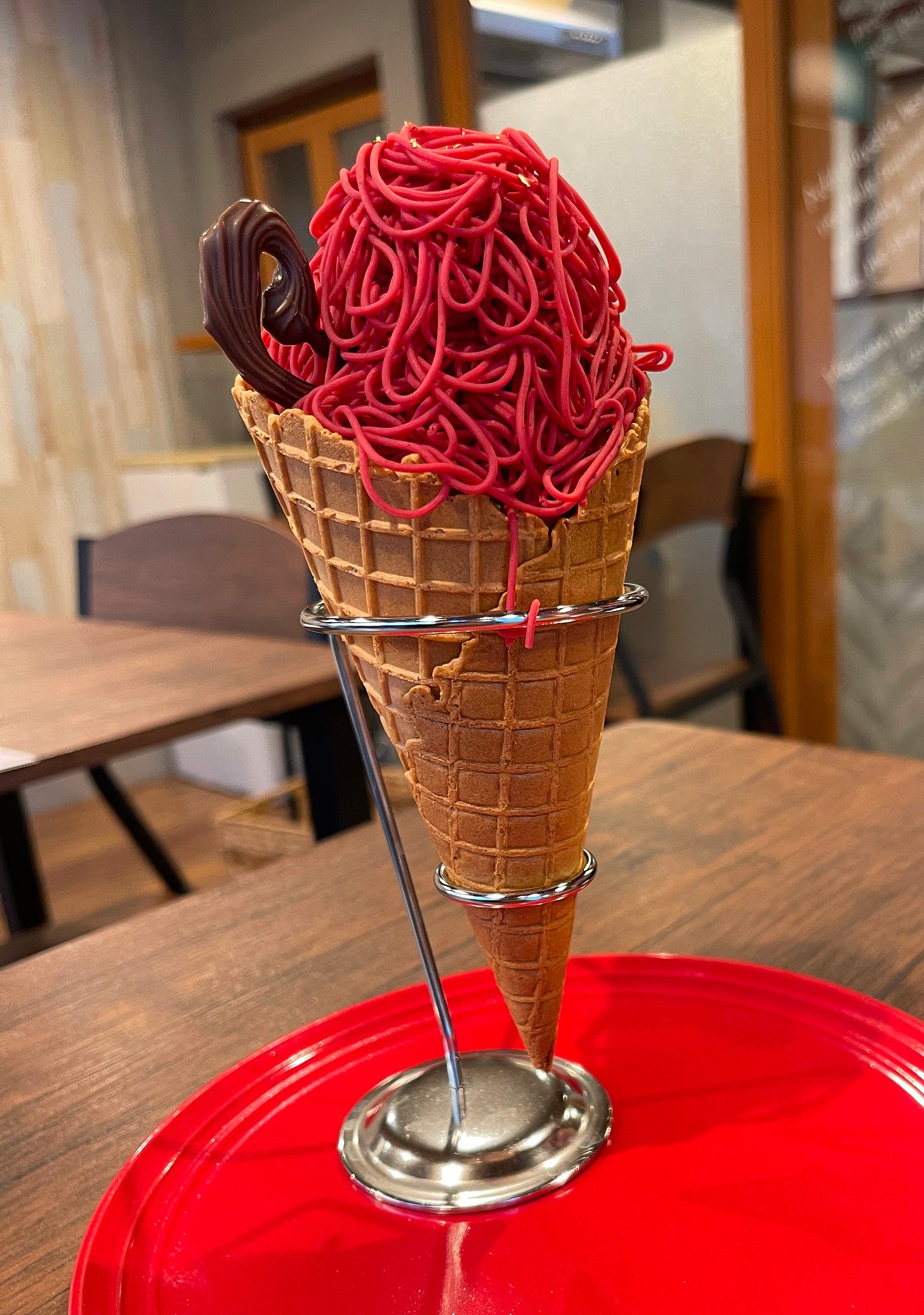TOKYO review
RANKED, my comprehensive review of 18 cafés and restaurants I tried in Tokyo on my latest trip.
five days
four nights
vending machines whisper
in tongues
of plastic.
Pho Hanoi Yatai 33 (2/10)
Curiosity piqued by rumors of the terrors of Vietnamese cuisine in Japan, we decided to embark on our own taste test. After scanning Google Maps, I was initially seduced by the unnecessarily cute Japanese-style plating— Vietnamese food presented as a Japanese set meal was too charming to pass up. A pho set arrived with a donut, side salad, single spring roll, and a shy bite of banana chè for dessert.
An ensemble too cute to be true; the charm ended there. The lemon chicken pho—while visually arresting—bore no resemblance to pho gà. What should have been a symphony of herbs and comforting broth dissolved instead into the cloying artificial taste of a yellow plastic-squeeze-bottle-lemon.
The 3-colored chè was presented in a perfect parfait glass, topped with jello cubes as if floating in a dream... It was a visual delight, though flavor-wise, was nothing special. Still, the memory of the restaurant lingers, the spectacle outshining the taste.
MORETHAN BAKERY (2/10)
Tucked away in an inconvenient nook of Tokyo, this bakery made us work for it. A long trek, rewarded with a line—a promising omen, we thought. Surely, the anticipation was building toward something MORE THAN ordinary. Having dabbled in the world of vegan desserts for three years, I was expecting great things from Japanese pastry chefs. But the moment I bit into the pastries, that illusion crumbled faster than the dry, flavorless bread in my hands.
Famichiki (Family Mart) (2/10)
This nugget has achieved a cult-like status—a viral sensation in all its deep-fried glory. Naturally, we were drawn to it, like moths to an oily golden flame. But make no mistake, it’s a chicken nugget in hypebeast clothes, and deep down, we knew it.
The first bite was a deep-fried-plunge into a memory—a school cafeteria, where the grease glistened under fluorescent lights. It tastes like nostalgia, but not the kind you long for. Oily beads sit on your fingers, the nugget clings to you like a secret you didn’t want to know.
It serves a purpose. In a moment of weakness, it’s there, reliable as a greasy companion. Not remarkable, nor transcendent, but ready. A nugget for when all you need is something greasy to hold in your hand and call food.
Tokyo Tarako Spaghetti (4/10)
In the heart of Harajuku lies a widely beloved spot for Japanese-style pasta. As a devout Japanese-Italian pasta lover and maker, my excitement bubbled over. We joined the serpentine line, drawn by the promise of culinary delight. After a bit of waiting, we settled in, eager for what was to come.
The classic tarako and shiso spaghetti arrived, plated like visual poetry. Yet, that first bite unraveled into disappointment. Flavor danced just out of reach—both dishes felt like shy whispers lost in translation. The noodles, a curious blend of wheat and tapioca, resembled boba or udon more than the thick Japanese wheat pasta I typically favor for my fusion Italian dishes (which you will definitely see some recipes for in the future)….
And then came the mentai ice cream. Rock solid, icy, and void of flavor.
The experience lingered like a half-remembered dream, where the quality of ingredients shimmered but the flavor faded into the background. If your palate seeks milder flavors, their pasta might just resonate.
SYNdicate cafe (5/10)
Conveniently in the heart of Harajuku’s rush, we sampled pudding, dorayaki, and an iced americano: charming and well-served, each bite was like a whisper of something memorable, just faint enough to fade. It was cute, a small delight—but nothing special.
Komeda’s Coffee (6/10)
A café chain scattered across Japan, dressed in classic Americana. The logo (a cowboy sipping a cup of coffee) mirrors one’s experience of sipping the cup of coffee the logo is on. You become the cowboy. That’s exactly the appeal of Komeda, living in a corporeal Japanese take on Americana. It is fantastic, as is the melon soda served in a glass boot. Pastries are edible, leaning sugary with ice cream and syrup piled high (too sweet). Coffee holds its own, diner-style, dark and just bold enough. Overall, it’s fine—more charming than groundbreaking. But the real draw is the cowboy ambience and charming logo.
Denny’s (7/10)
In Akihabara, after hours of sensory overload, Denny’s Japan offers a reprieve. An American name, but inside—something else entirely. Unlike its U.S. counterpart, this family restaurant carries the warmth of western-style Japanese comfort food, met with thoughtful hands-off hospitality.
A line awaited, perfectly structured. Queue chairs lined up, each diner in sync: as one was called, the row slid forward in smooth, harmonious flow. There was something strangely satisfying about this order, an unspoken rhythm I didn’t know I needed. Inside, an introvert’s dream setup: a touch screen interface for self-serve ordering.
Oolong tea from the drink bar is refreshing, balanced, grounding, and not astringent. And then, the classics: omurice with its thickened sauce, a plate of hamburg steak that arrives tender, balanced, each bite holding the rich, savory notes. There’s a quiet satisfaction here, something distinct hiding beneath the familiar logo—a sense of place wrapped in the guise of the familiar.
PRONTO (7/10)
A quiet entry—no pretense. No line, no frenzy. Just a chocolate cornet, retrieved from the counter in the shop where fluorescent lights hum and laptop screens glow softly. A steady rhythm of unspoken rituals underlines each moment, as patrons sit quietly, weaving work and pastry in understated harmony.
The choco horn itself—a lesson in texture. Soft, moist, pillowy bread with a slight chew, giving way to a chocolate ganache that finds balance: firm enough to satisfy the tooth, never veering toward dry or too dense. It’s the kind of pastry that doesn’t ask for applause, just a pause, a moment that fits within the ordinariness of a day without demanding more.
7-Eleven (7.11/10)
For many, a staple; for us, too, the ritual took form: daily visits, a rhythm set to quell the familiar Californian craving for fresh produce. The needs sharpened by absence, our minds attuned to one remedy—fruit and vegetable blended down to the essentials. Each smoothie held a promise of familiarity, a bridge to the known within Tokyo’s particular pulse.
A five-minute walk to the nearest 7/11 resulted in the ritual of grabbing a kale smoothie, the best and most consistent offering at the establishment. Ritualistically, we grabbed the cups from the freezer and popped them into the magical machine that blends the frozen fruit delicately placed in a plastic cup— with every revolution of the spinning blades, I prayed for the least amount of microplastics.
One late night, fueled by jet lag and hunger, a salmon onigiri from the Shinjuku 7/11 was the answer. Unwrapping it revealed the thinnest, most shattery and umami seaweed I have ever encountered. The rice was soft and fragrant—truly the best onigiri I’ve experienced.
What makes 7/11 great is the freshness of the food offered. However, the quality can vary significantly due to distribution. For our last meal in Japan, at the airport en route to Korea: an onigiri, strawberry cream sandwich, and Baumkuchen. The onigiri lacked the freshness that had been expected, indistinguishable from a standard option at Tokyo Central in LA. Yet, the strawberry cream sandwich surprised me with its bright red, sweet strawberries— offering a sweet farewell.
7/11 transforms into a sanctuary of simplicity, each visit a sacred rite, a pilgrimage through aisles of everyday offerings, where joy is found in the communion of daily rituals.
Mos Burger (7.3/10)
In the tapestry of Tokyo, Mos Burger emerges as an unexpected haven. A chain that defies the usual tropes, it offers a uniquely Japanese take on a western burger. Here, the essence of quality transcends the typical, a realm where freshness reigns supreme.
The shrimp cutlet burger offers a study in textures: a crisp, golden coating that gives way to a tender interior, each layer distinct yet symbiotic. The classic beef burger introduces contrast with a bright, juicy tomato and a restrained layer of creamy cheese. Both burgers manage a balance—elemental in approach, yet texturally complex.
The oolong tea is perfectly steeped, unsweetened yet robust, grounding the experience in a warm embrace without a hint of astringency. In this seemingly simple beverage, there’s a precision that Mos achieves—tea brewed to an ideal strength, balancing warmth with clarity, unsweetened yet full-bodied. Mos Burger, an expansive chain, yet within its walls lies a sanctuary, a retreat for those seeking solace. It belies a comforting reliability: I found myself returning, for a space where stillness and quality coexist, and the oolong tea...
Onibus (7.4/10)
The allure here stems from a second-story view, an angle on Nakameguro that frames a train and neighborhood life in passing. Inside, pour-over coffee fills the menu—not my usual preference, as I lean more toward espresso, but I was open to see what flavors they have unlocked with their beans. Two single-origin options reveal a quiet, earthy richness without major standouts in flavor profile, but the quality still holds.
Architecturally, the place lives up to its reputation: a small, charming room, quaint to the point of feeling removed, capturing a sense of personal space within a well-loved building. The appeal, though undeniable, is subdued by its popularity, creating an atmosphere less about quiet observation than shared instagrammable spectacle. Overall, I genuinely appreciate the commitment to sustainably sourced beans, and would recommend this spot for that reason.
Seirinkan (7.6/10)
This spot— with the reputation as Tokyo’s pinnacle of pizza— demands patience. With a line that can stretch for hours, we anticipated the wait, arriving 15 minutes before opening, resulting in an acceptable half-hour wait. Inside, an ascent up an iron spiral staircase led to a second-floor bar seat: unobstructed views of the industrial coffee kitchenette.
We began with the insalata verde, a straightforward dish with a fresh and tangy crunch that set a steady tone for the meal. Next, the pizzas arrived: a classic margherita and the marinara. Neapolitan-style down to the leopard-spotted crust, the pizzas embodied an authenticity not just in ingredients but in a texture. The dough was soft and fragrant, a canvas for tomatoes bursting with natural umami, and the mozzarella—mild, creamy, undeniably fresh.
Interestingly, it was the marinara pizza that ended up being my preference. Elevated by a herb-infused olive oil, each bite brought an unexpected depth that felt almost engineered for flavor, resonating with a subtle, yet distinctly elevated quality.
Between bites, the mandatory sparkling water punctuated the meal, cleansing and resetting. Dessert came in the form of a tiramisu presented in a charming glass—unexpectedly loose in texture, but strikingly rich in coffee and liqueur. Though not as structured as typical renditions, it held an intense, lingering depth of flavor.
Cremia (7.8/10)
Cremia soft serve comes with a weighty reputation—often praised as among the world’s finest. After searching across several Excelsior Caffes, we finally stumbled upon it in Nakano. I was ready for the experience, especially as an ice cream lover with a penchant for making my own. In LA, with its rich roster of ice cream shops including top-tier soft serve, my expectations were set high.
The presentation of Cremia is stunning: soft serve spirals elegantly, its silhouette like a church spire in a biscuit cone. The flavor profile —a concentrated milkiness enhanced by a hint of salt, almost like a delicate, near-cheesy umami undersong lifting what soft serve can say. For a milk-based soft serve, this flavor was nearly ideal, capturing complexity without overwhelming.
Yet texturally, Cremia diverges from what I expect in a great soft serve. Instead of the dense creaminess I anticipated, the texture leans toward icy, nearly crystalline, a textural moment that disrupts the expected soft serve lushness. The biscuit cone itself, a departure from the caramelized crunch of American waffle cones, offers a more understated flavor, highlighting the subtle wheat flavor of Japanese biscuits.
For me, the textural dissonance alone marks Cremia as a good ice cream rather than a great one; the flavor is grounded in finesse but overall, it’s shy of the full-bodied indulgence that defines true soft serve mastery.
Takemura (7.9/10)
After a day in Akihabara’s electric haze, this quiet retreat in a 1930s building held a different kind of charge. Inside, the uncluttered simplicity of a traditional Japanese establishment—a wooden, almost ascetic calm. The pared-down dessert menu minimizes decision fatigue; anmitsu with red bean paste and ice cream felt like the natural choice. The space itself, hushed and worn, seems to absorb sound, perhaps even radiate it back as an almost palpable calm.
The server arrives with a complimentary sakura tea: warm, saline, and floral to precondition the palate, gentle yet layered. The cool anmitsu follows, a composed array of fruits structured with mild sweetness, anchored by a side of black sugar syrup. The ice cream seems almost extraneous, a outlier in sweetness in an otherwise balanced arrangement.
Here, simplicity operates like a complex mechanism, every piece set precisely. Service, structure, and flavor unify in a way that harmonizes the dessert and the experience.
Khunmae Shin-Ōkubo (Thai) (7.9/10)
Just beside our Shinjuku hotel, this Thai restaurant was a haven of warmth, the entrance filled with an array of potted plants spilling across its front like an urban garden. After days of Tokyo’s more subtly spiced flavors, we missed the bright, spicy undertones we were used to at home. One evening, despite already having had dinner, we found ourselves drawn in by the inviting setting, a promise of new tastes.
The first surprise: a full pitcher of unsweetened, creamer-free Thai iced tea. The distinct flavor was there, but without the usual weight or sugary edge. Sipped from traditional ornate aluminum cups, it was a refreshing revelation, a lighter, almost ceremonial drink.
With enthusiasm, we ordered a few dishes—fish cakes with lemongrass, papaya salad, and a Pad Thai adorned with an egg blanket, reminiscent of omurice. The fish cakes, fragrant and delicately spiced, balanced the punchy, fresh crunch of the papaya salad. The Pad Thai itself may have been standard, but the presentation added a thoughtful twist.
This small, unassuming restaurant brought a new layer to our Tokyo trip, standing out among quieter flavors for its vibrancy.
LOU (8.5/10)
Tucked into the charming alleyways of Nakano, this cozy café hums with low copper tones, wood accents, flowers on each table, and a turntable spinning old American records that underscore the gentle, familiar ambiance. We arrived at peak lunch hours, joining a quick-moving line that kept us safe from the rain about to fall.
Our start: iced americanos and carrot cake. The americano stood out—probably the second-best coffee we’d had in Tokyo—balanced, and lingering just enough. The carrot cake was equally memorable: not too sweet, carrying an earthy undertone, its flavor delicate and unassuming.
For the main event, two soups: pork & cabbage vinegar and cod potato tomato, served with a generous piece of house-made focaccia. Each soup tasted like an homage, Scandinavian in feel but adjusted for Japanese tastes. The flavors were nostalgic, echoing the soups I’d once made living in Denmark. The pork and cabbage felt earthy, with a slight tang from the vinegar, while the cod, potato, and tomato combined into a creamier warmth. Familiar yet distinct, both were grounding in a way that balanced the café’s atmosphere.
The Beet (8.5/10)
An unexpected find wandering the streets after a visit to the Grounds flagship store; we’d been searching for a café to pause in when we stumbled upon The Beet. Everything on the menu revolved around beetroot—an intriguing concept that can seduce any root-vegetable-lover (like myself). Drawn in by the stillness of the place, we entered, finding ourselves the only patrons, as though we’d discovered an invitation only we could see.
The menu featured açaí bowls, and a surprising beet mont blanc—a favorite dessert, transformed. Its presentation felt ceremonial, with delicate jellies and even a flourish of gold flakes. The café owner brought the mont blanc extruder to the table, performing a slow spiral of freshly grated beet chestnut cream over the top, the process intimate and precise.
Even made from beetroot, the mont blanc held the rich essence of chestnut, the flavors somehow deepening each other in a fragrant harmony. The texture, smoother and even richer than expected, took on a subtle, earthy complexity. Each jelly introduced new textures, adding brightness to the depth of the beet-chestnut cream.
coffee swamp (9/10)
Nestled in Shinjuku's alleys, this café emerges as a compact haven for those who consume coffee as both ritual and revelation. Outside, the chill of the morning settled into our bones, urging us to seek warmth within the café's embrace. The space itself is small and radiates a crafted intimacy, its walls lined with custom wood furniture and every detail considered, down to the turntable spinning vintage American vinyl—an indicator of Tokyo's hip cafes.
I ordered a hot americano, something to cut through the cold, the kind of drink that felt like it could thaw the morning itself. Every shot here seemed calibrated with a meticulous hand, the espresso dark and resonant, revealing layers of chocolate that softened into an unexpected fruitiness, bright like cherries. It was the best hot americano I’d encountered, each sip revealing new notes of flavor.
The cortado followed, balanced in flavor and texture, measured to bring out the espresso’s richness without overpowering it. Here, coffee was not rushed; it was savored, treated as both a practice in craftsmanship and pause, a way to ground oneself .

